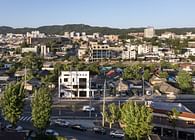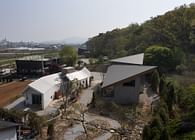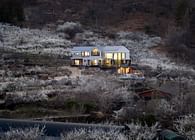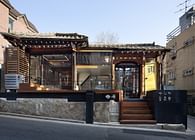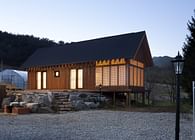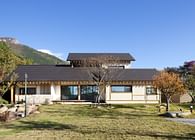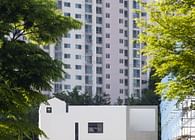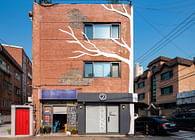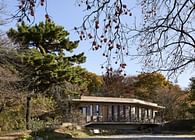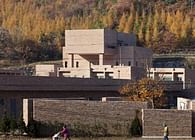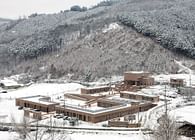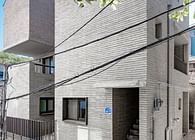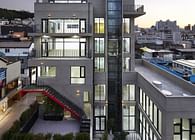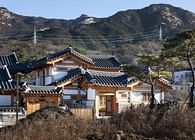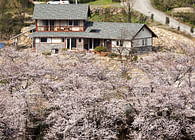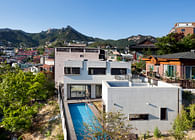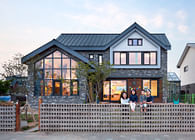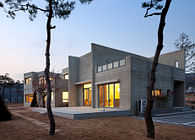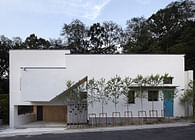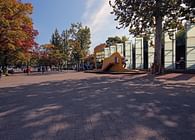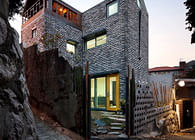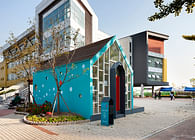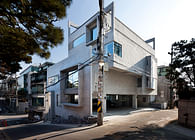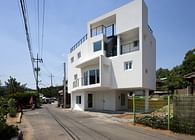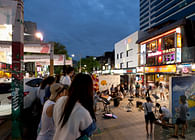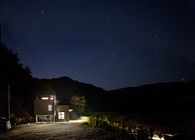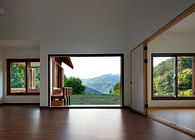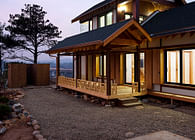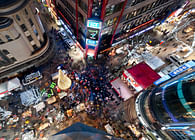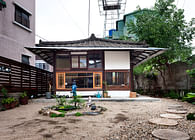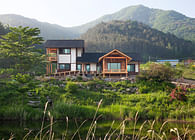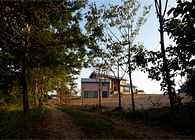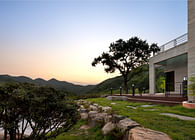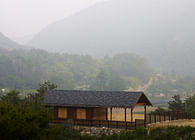
Seoul, KR
On a late autumn Saturday morning, two very cheerful couples from Busan came to our office in Seoul. As soon as we met, we began to talk as if we had known each other for a very long time. The two-year-old siblings who both got married and were raising families, were preparing to build a house together. The older sister and her husband had 6-year-old daughter and 4-year-old son. The younger brother and his wife had 8 and 6-year-old sons. In total, they have four children. They said they had concerns taking care of the children when they enter elementary school, so they decided to build a house together and find a way to co-parent.
They searched for a long time to find a site and found a piece of land inside an old alley in Myeongryun-dong, Busan. They decided to build a 'duplex house' there, which is affectionately called a 'peanut house' in Korea. Duplex house type has also been in vogue as an alternative to single-family homes for some time in Korea. Out of this meeting, we got to build our first house project in the city of Busan. Busan is the second largest city in South Korea and is a port city with a long history. The site for the house is near Dongrae Hyanggyo ('Hyanggyo' is an institution of higher education during the Joseon Dynasty.) It is located directly across the street from the cultural relic.
The site sits a short walk away from the main street on a narrow and shallow alleyway, and it is quite visible from the Hyanggyo. The site is surrounded by low, dilapidated old houses and tall and low-lying buildings lined up like overgrown weeds. It is a narrow and elongated piece of land, and the narrow width is a disadvantageous condition for designing a duplex. The twisted trapezoid shape of the site is unfavorable to design two units with equal light and ventilation conditions, as well as the sunlight and views.
In addition, the direction of the north, facing Hyanggyu, was the most open view from the site, and it was too difficult for the two houses to face the view equally. To the south, a three-story house was close by, so it was not easy to secure light. The area of the land was also limited, the maximum area of one floor was 106 square meters, which divided into two, was a mere 53 square meters. Considering the size of the household of 4, at least three floors for each household were needed. To give the two houses equal conditions, the idea was to reverse the location of each household every other floor so that each house could face all the directions, just as in single-family house.
In other words, the principles of planning are 1. Function as separate unit, while existing as one single mass 2. Equal conditions for both houses 3. Secure view of Hyanggyu for both household. Also a courtyard for light and ventilation in the middle of the house was essential. After conducting a in-office competition for the shape of the staircase, we came up with a double spiral staircase that wraps around a tubular courtyard which winds up like a snake as it rolls around. The staircase can be climbed alternately to the right and left as you go up the floor, giving both households a view around site in all four directions. The two separate stairs do not cross each other, but they can interact with each other through the openings.
We showed this unusual floor plan, which both families liked. It was also the best solution in the situation where buildings and roads were jammed on all sides, as if they were trapped in a narrow barrel. For we had to design the maximum volume the law allowed, the complex interior was wrapped in a simple brick mass so it is not too prominent in the old neighborhood. The openings were placed considering the relationship with the adjacent houses and the view to Hyanggyo, and the purpose of each room, stacked vertically, was decided after several consultations. Starting from their respective entrances in the front, they climb the floors as they intersect and eventually meet on the rooftop, where the closed curves weave together through the interior of the house. And for the convenience of the five-story house, a small elevator that opens in both directions was planned.
The construction of the house, which is simple on the outside but quite complex on the inside, was undertaken by a company called En-One. The young head of the construction company calmly proceeded to work without any complaints despite the narrow access road and difficult surrounding conditions. Again, the most difficult task was to make a double spiral-shaped staircase wrapped around a cylinder by forming a mold of concrete, tying reinforcing bars, and pouring concrete. He built the structure in a slow, grueling process. We watched the process in awe. As the structure was raised, the fence, roof, and bridge of the front house gradually began to come into existence. It took four seasons. In the irregular landscape of the old town area, the house was completed with a modest exterior and a swirling interior space.
The first floor is where you meet the neighborhood and enter the house. A little piloti space was created for a parking compartment. Since the roads in the two directions meet, there was no room for a garden, so a circular courtyard was added inside. When you enter the front door, the personality of each house is revealed with smooth tiles and free-flowing tiles. The placement of a hand-washing sink at the entrance is a consideration for children's hygiene after experiencing Corona pandemic, and the elevator entrance is next to it. When you enter through the arched door, you will find a double-spiraled staircase, and in the middle of it is a courtyard like a round well that lets in light and allows ventilation. Behind it is a common area (a children's library and play area) that can be shared by both houses.
The second floor houses the children's bedrooms, while the south room encases a two-story bed, which is often called a "bunker-type bed" these days. The height of the floor was raised to match the height of the bunk beds, which resulted in a change in the height of the kitchen on the third floor. Under the bed, there is a niche space where children can play, and there is a room with a large window towards Dongrae Hyanggyo with a good view. When you come out of the stairs, there is a wooden bench to sit by the window.
The third floor works as the middle ground and the space where the living room and kitchen are located. In other words, the 1st, 3rd, and 5th floors are public spaces, and the 2nd and 4th floors are private spaces with bedrooms. Of course, the living room is on the north side of the Dongrae Bridge to a nice view, and the south side is the upper part of the bunker-type bed room, so it becomes a three-dimensional space where the height of the floor changes. The staircase between the living room and the kitchen doubles as a bench-like space where you can sit and relax. By raising the south room on the second floor, the height of the upper floors has been lowered, and the living room feels very high in comparison. In fact, the sense of height and width is relative, so if you go through a narrow space to a space that is slightly wider, you will think that it is very wide, and the same is true of height. Most of the family members in this house will probably stay in this space and spend time together.
On the fourth floor, the couple's bedroom is located on the north side, facing Donglae Hyangkyo, and on the south side is the study and hobby room. Due to the different tastes and personalities of the two houses, the west side of the house has a bathtub, shower, sink and toilet together, while the east side of the house put the shower and toilet into a compartment with a door, and moved the sink out. The sunny veranda hung at the south end, so the washing machine was placed next to the sink.
And the last floor, where the attic is attached, is a space where the two houses can finally meet with a panoramic view in all directions. Along with the library on the first floor, it symbolizes the circulation and amalgamation of space.
Status: Built
Location: Busan, KR
Firm Role: architect
Additional Credits: Architect : Hyoungnam Lim, Eunjoo Roh in studio_GAON
Project Team : Hwawon Kim
Photographs : Yong kwan Kim, Seok gyu Hong
Location : : Myungryun-dong, Dongrae-gu, Busan, Republic of Korea
Use : Residence for two families
Site Area : 187㎡
Building Area : 111.22㎡
Gross Floor Area : 398.76㎡
Building Scope : 4F
Height : 14 m
Building-to-Land Ratio : 59.48%
Floor Area Ratio : 213.24%
Structure : Reinforced Concrete Structure
Finish : Brick Tile
Construction : N1 Architecture

